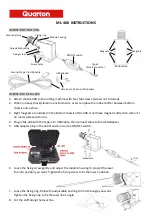
Technical Description: System
Cracking Patterns
Thermo Fisher Scientific
Prima PRO & Sentinel PRO Mass Spectrometers User Guide
B-17
The sequence of peaks representing a particular gas species is a
direct result of how that species reacts under electron impact in the
source. Depending on the species, the molecules can undergo a
variety of reactions within the ion source, and the resultant set of
peaks is referred to as the “cracking pattern.”
A single gas species may produce a variety of different ions giving
rise to several peaks of different mass-to-charge ratio and intensity.
The relative intensities of these various peaks are characteristic of the
gas species in question, although the peak intensities may be affected
by changes in source conditions (such as electron energy). The
relative intensities of the different peaks can be used to de-convolute
the composition of a gas stream containing components of the same
molecular weight.
Some of the different types of ions that can be produced within the
ion source are described below.
This is the simplest reaction to understand and results from the gas
molecule acquiring a single positive charge as a result of electron
impact in the source. An example of this type of ion would be the
14
N
2
+
ion for nitrogen at m/e 28 amu.
The molecular ion peak may not always be the peak with the highest
intensity in the mass spectrum for a given component. This is
especially true for hydrocarbons, where the fragment peaks are
usually statistically more likely to occur than the molecular ion.
Isotope ions are produced when one or more of the atoms that
comprise a molecule are of a different isotope from that most
commonly found. The relative intensities of these ions are defined by
the relative abundance of the different isotopic species for the
component atoms in question. The relative intensities of isotope
peaks are not normally affected by changes in source conditions.
An example of an isotope peak is the m/e 29 amu peak observed in
the nitrogen mass spectrum. This peak results from a single charge
on a nitrogen molecule where one of the two nitrogen atoms is the
15
N isotope. The relative intensity of this peak to the molecular ion at
m/e 28 amu is twice the natural abundance of the
15
N atom (since the
15
N atom could be either of the two atoms).
Cracking
Patterns
Ion Types
Molecular Ion
Isotope Ions
Содержание Prima PRO
Страница 3: ......
Страница 5: ......
Страница 23: ......
Страница 45: ......
Страница 49: ......
Страница 85: ......
Страница 129: ......
Страница 189: ......
Страница 195: ......
Страница 203: ...Regulatory China RoHS F 4 Prima PRO Sentinel PRO Mass Spectrometers User Guide Thermo Fisher Scientific...
















































